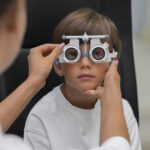Hey there, parents! Today I’m going to share more about a topic I personally struggle with – screen time management!
The Screen Time Dilemma
Let’s face it, in today’s world, screens are everywhere. And our kids are attracted to them like moths to a flame. Some types of digital content certainly helps develop our child’s brain and stimulates creativity. However, we all should be wary of the how much time they spend and what they spend it on. The American Academy of Pediatrics recommends no screen time for kiddos under 2, one hour per day for the 2-12 crowd, and two hours for teens. Bear in mind that these are guidelines and it may not be practical for you to stick to it consistently. So I will educate you on the risks and cover some tips that may help you manage the problem.
The Risks of Too Much Screen Time
Now, let’s get real about the risks.
Short term:
- Dry Eye & Digital Eye Strain: When kids are on the screen, they tend to be fully engrossed. They also blink less often. This leads to dryness in the eyes, blurry vision, headaches and fatigue.
- Sleep Disruption: Getting exposed to a screen close to bedtime makes it harder to fall asleep
Long term:
- Myopia: Spending a lot of time looking at screens up close can lead to myopia, where distant objects look blurry. Myopia is becoming more common in children due to increased screen time. As per this study, myopia affects 42% of children between the age of 5-19 years. Asian kids have the highest risk.
- Retinal Damage: Prolonged exposure to blue light from screens can potentially harm the retina, the light-sensitive layer at the back of the eye. While research is still ongoing, there is concern that long-term exposure could increase the risk of retinal diseases.
- Neck and Back Issues: Have you heard of a term called text neck? I hadn’t heard of it either till I researched this topic. It refers to impact of leaning forward for long periods on your spine, neck and shoulder.
- Mental Health Concerns: There are many studies which link prolonged use of digital devices, especially social media apps, to mental health of kids.
Expert-Approved Tips for Healthy Screen Time
Now that you are aware of the risks, let’s look at some practical tips:
- More outdoor time: This is kinda obvious. Being indoors and away from screen is good but not enough. If your kid is drawing, reading, etc., it’ll still put strain on their eyes. Being outside helps them focus focus on objects that are far away and helps strengthen eye muscles. This reduces the risk of myopia.
- Technology to counter technology: Most modern devices have settings to control screen time for kids. iOS offers the Screen Time and Android offers Family link settings to control screen time for your kids. There are also third party apps like Qustodio that can help.
- The 20-20-20 rule: If screen time is unavoidable, you can minimize eye stress with the 20-20-20 rule. Every 20 minutes, take a 20-second break and focus your eyes on something at least 20 feet away.This practice allows your eyes to relax and reset, breaking the constant focus on close-up screens.
Finding the Balance
Ultimately, it’s all about balance Some research suggests that not all screen time is created equal. High-quality, educational content can actually boost skills and emotional intelligence. So, if your kid is learning useful things, expressing his/her creativity, don’t fret over the screen time. Instead, focus on the things that you can control.
Join Our Community!
Stay updated and swap tips with other parents by joining our WhatsApp group. Share this post with fellow parents and invite them to join too. Together, let’s keep our kids’ precious little eyes healthy.




